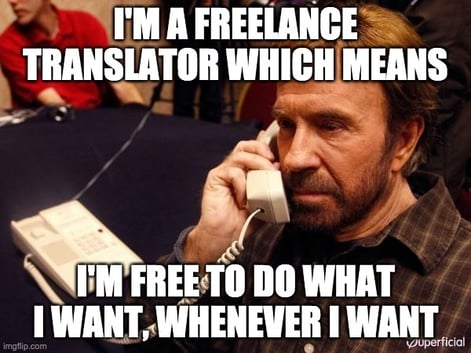
What is the difference between translation projects handled by translation agencies and freelance localization professionals?
Do translation companies provide different services than freelance translators?
Thanks to ATL's experience in working with end-clients, other translation companies and freelance translators, this article was created to compare the services that you get from a localization company and from freelance translation professionals. This is to help you decide which path to choose when you start working on your international business growth.
There are certain aspects of collaboration with both types of language services providers that need to be considered.
.png?width=510&name=professional%20linguists%20availability%20(1).png)
Product or service availability is a must these days. Today, at the age of fast customer service, nobody wants to wait.
People are used to switching providers if one is not available, therefore you need to be fast, too. If there is an update on your website and the translation is not available immediately, you may lose a local customer.
Freelancers usually work within the standard working hours. However, the fact that they can work anytime and anywhere gives them a lot of flexibility. Some of your emails could be answered after their usual availability span. However, the same may happen the other way round. It may happen that your email will not be answered during your regular working hours.
You may even receive a response similar to this:

These are the pros and cons of working with a freelancer. In most cases, the availability is adjustable. In some cases, this will suit your needs, but in others - it won't.
Translation companies employ localization project managers, who are responsible for providing customer service during standard working hours. Moreover, translation agencies often arrange shifts so that the organization can support their clients within their time zones.
Thanks to the collective efforts of the whole team, the localization company is able to provide better availability than a single person.
Advanced organizations also incorporate technology in order to support clients and their needs. And it doesn't matter if the office is officially open or closed. This happens through all sort of customer portals accessible 24/7 or integrations that connect systems and streamline translation workflow. The technology aspects of translation will be covered more in depth later in the article.
Back to the translation professionals' availability. When the only person responsible for your localization project is on vacation, it means your content translation is put on hold.
Localization companies cooperate with many professional linguists so that they always have a back-up for the holiday season.

Let's start with CAT (Computer Assisted Translation) tools. CAT tools are often referred to as translation software. The main features of the software are:
What is the difference between working with a freelance translator and a translation company when it comes to CAT and TM tools?
Translation companies worth their salt do not work without translation management software. There are, however, freelance translators that still refrain from using CAT tools and Translation Memory technology.
Fortunately, most of the localization professionals use CAT tools for the sake of translation speed, quality, and consistency. Translation companies often use a few CAT tools or Translation Management Systems. Thanks to localization engineering and the file preparation capabilities, they are often able to work in a CAT and TMS regardless of the source and format of the content that they received from their clients. Freelancers tend to stick to one, favorite translation software.
There is also the case of the cost of the translation tools. Most freelancers will look for the opportunity to work through the license assigned by the client. This is fairly understandable, as the more clients they have, the more CAT tools they need and, none of the professional translation software is free.
Translation company is not only equipped with the translation tools but very often, they provide licenses to the client's in-country reviewers who check the translated content and provide feedback to the linguists.

The in-country reviewers are usually subject matter experts like software developers, website designers or product distributors who are native speakers of the target language. They are not professional linguists, though, and usually they don't have access to the translation tools unless the translation agency grants it to them.
Localization service providers also have the ability to integrate the translation software directly into the client's systems. The connections enable fast and efficient content flow.
Related content: Lack of Translation Integration With Your System: Trouble Alert
Translation integration allows the translation agency to access and translate the source text without the need for the content to be exchanged in files. Such connections can be created through existing integrations, APIs or custom solutions. All of that requires investment and experience.
Unless you want to do it with your own resources, it's better to go for a translation company.

The majority of translation companies are ISO (International Organization for Standardization) certified. These standards guarantee the constant level of service and quality. In order to pass and renew the certification, a thorough audit has to be conducted. All steps of the workflow and aspects of the localization process are examined.
One of the ISO 17100:2015 standard requirements is providing translators with feedback.
It is true that translation companies cooperate with freelance translators but the quality provided to the client is not that of a sole freelance translator's work. The translation delivered to the translation company is not what is delivered to the client because the translation is followed by another step, called revision. Revision is a bilingual examination of the source text and the translated content, conducted by a separate linguist.
The revision step is accompanied by translation evaluation which is passed to the translator. In this case, the translator is aware of any issues with the delivered work. Otherwise, the potential issues will not be detected or not reported, and could be continued.
Related content: A Guide to Understanding Translation and Localization Terminology
.png?width=468&name=translation%20turnaround%20time%20(2).png)
Freelance translators deliver their work faster than the translation company.
They conduct one step of the process and therefore the translation is ready quickly. Translation companies conduct the full workflow, and therefore their deadlines fall well after the translation is ready.
Of course, if you wish to assign the translation step to one linguist and then arrange a revision stage, it's possible. This scenario, however, may take the longest. Manually managing the flow of the files and project instructions is time-consuming.
Organizing the linguists' communication regarding the reviser's edits may lead to many back and forth emails.
Translation companies use technology and other solutions in order to streamline the process. Moreover, they manage your Translation Memory and update the project resources such as the QA checklists and specific project instructions.
There are solutions that help translation companies streamline the localization process. One of them is working with a group of linguists. In this case, a few translators are working on one project, and all their translations are immediately saved into one shared Translation Memory.
The TM, which is accessed by all the linguists which ensures consistency of the content. The other solution, which accelerates the localization project, is to incorporate a reviser into the project before a whole file or document is ready. The usual scenario while working with freelance linguists is that the reviser can't start before the preceding step is finished.
Related content: How to Reduce Turnaround Time for Content Translation
With regard to translation companies, it is possible for translators and revisers to work almost simultaneously. This is possible thanks to the tools they use and project managers, who guide the appropriate localization team cooperation.
.png?width=466&name=translation%20cost%20(2).png)
When asking how much the translation costs, make sure that the translation proposal includes all the services you need. In the majority of cases the translation company will provide the rate for translation and revision.
The quote will be based on the rate for the full localization process instead of just a translation service. Most probably, the quote will also include TM update, QA checks and project management on the translation provider's side.
Other values included in the rate are resources management, translation evaluation, and quality monitoring.
You don't have to worry about choosing the best linguists for your website translation, software localization or marketing translation. The translation company's vendor management team will select them for you. The same goes for checking the quality of the translation before you receive it. Be sure that, when you get it, it's been properly checked.
A freelance translator can provide translation or revision. The rate provided by the freelance translator is, in the majority of cases, a price for just one step of the whole localization process.
Please note, that while working with translation companies, the quotes are based on what is stored in Translation Memory.
At the beginning the TM is empty if you had not translated any content before. But the more projects you assign, the more savings will be generated from the translation database.
Related content: How Are Cost Savings Generated by Translation Memory [Video]
Freelance translators, who don't use CAT tools can't grant you TM savings. Cooperation with freelance translators may require working with several linguists. Unless you manage the Translation Memory, the segments that are already translated are not used for savings or consistency.
This, as a result, leads to quality issues that need to be fixed. The step of making the translations consistent requires additional time. It delays the whole project and creates additional cost. In result, your multilingual website launch, new software introduction or product rollout can be significantly delayed, affecting your revenue business growth.
The offer of freelance translators varies from what a translation company has to offer. Freelance translation professionals are often translators or revisers. They can also conduct both of the mentioned services, depending on which stage of the project they are assigned to.
Some of the linguists prefer translating, others are more into revising. Translation companies cooperate with so many freelancers that they do not limit their offer to one service. They simply have it all. And it's not just about translation and revision.

Translation agencies can also help you with localization engineering whenever the content needs adjustments. You can also count on DTP (Desktop publishing) specialists or voice talents for dubbing, subtitling, or voice over. Translation companies cover transcreation, linguistic testing and more.
You should take into consideration that a freelance translator can translate into one, or a maximum of two, languages. Translation companies, however, have access to a wide pool of linguists so that they cover multiple languages.
Therefore, they are able to cover a full scope of unrelated languages like: Chinese, Spanish, Italian, Korean, French, Japanese, Russian, Arabic, Norwegian, Portuguese or Polish.
Related content: 15 Languages for Translation in 2022 That You Should Know About
One of other differences between freelance translators and translation companies is the scope of the subject fields they specialize in.
Working with a freelance translators limits the variety of content that can be translated to few specializations only.
For example, you may collaborate with an excellent technical translator, who specializes in automotive. It is just perfect, if you need a technical translator for automotive content.
But what if you have a marketing content or legal documentation to be translated along with the technical documentation? You'll need another freelance translator, and a person to manage the growing team. In the end, it often turns out, that the best solution is turning to a translation company.
No matter if you are going to work with a freelance translator or a translation company, make sure to know their strengths and weaknesses. Make a list of what you need, and answer some relevant questions:
If you don't mind some of the disadvantages of working with a freelance linguist exclusively, go for it!
Just remember that the translation process should not slow you down. It's there to accelerate your global presence and help you reach your international audiences regardless of their location, in a fast and cost-efficient way.
Recommended articles:
+1 857 777 5741 ext. 203 (business inquiries)
+1 857 777 5741 ext. 205 (career inquiries)
Trylinskiego 16, 10-683
Olsztyn, Poland
Copyright ATL 2025. All Rights Reserved.